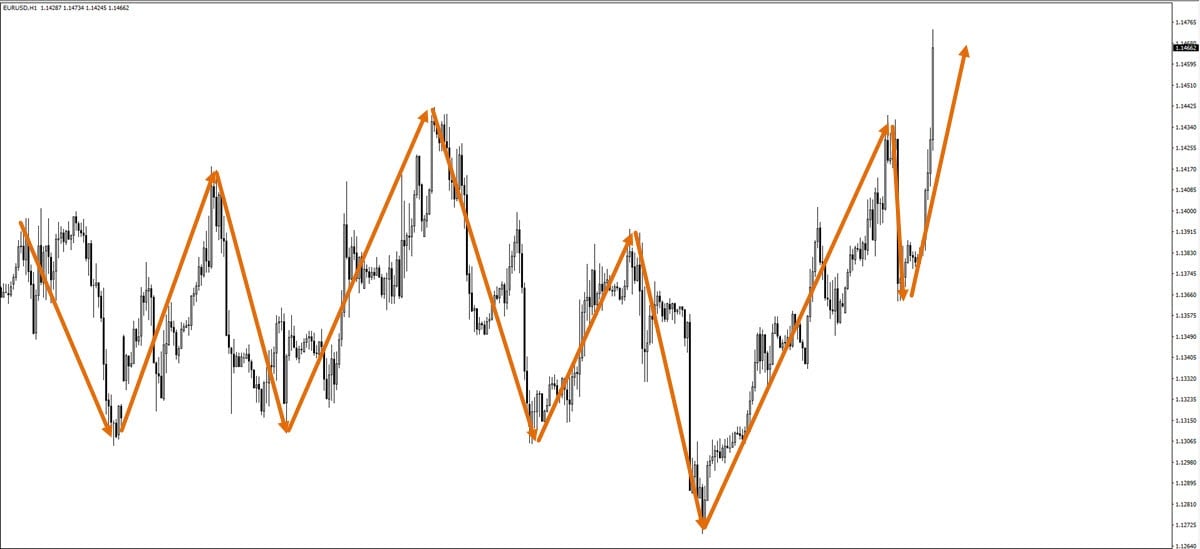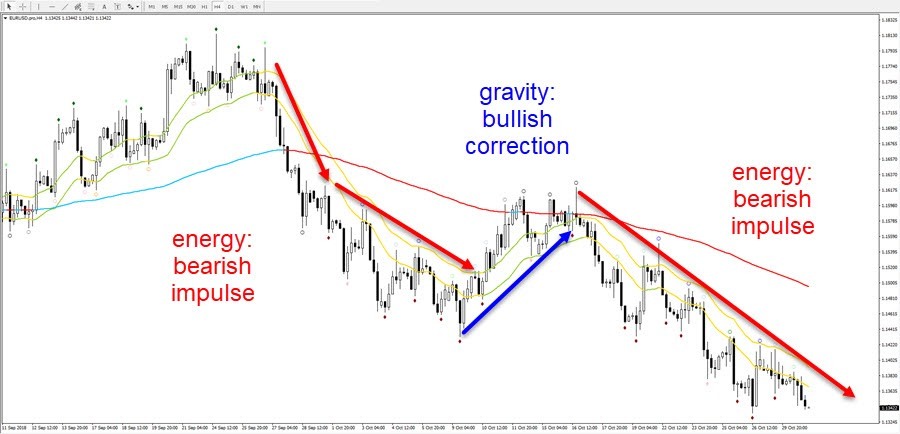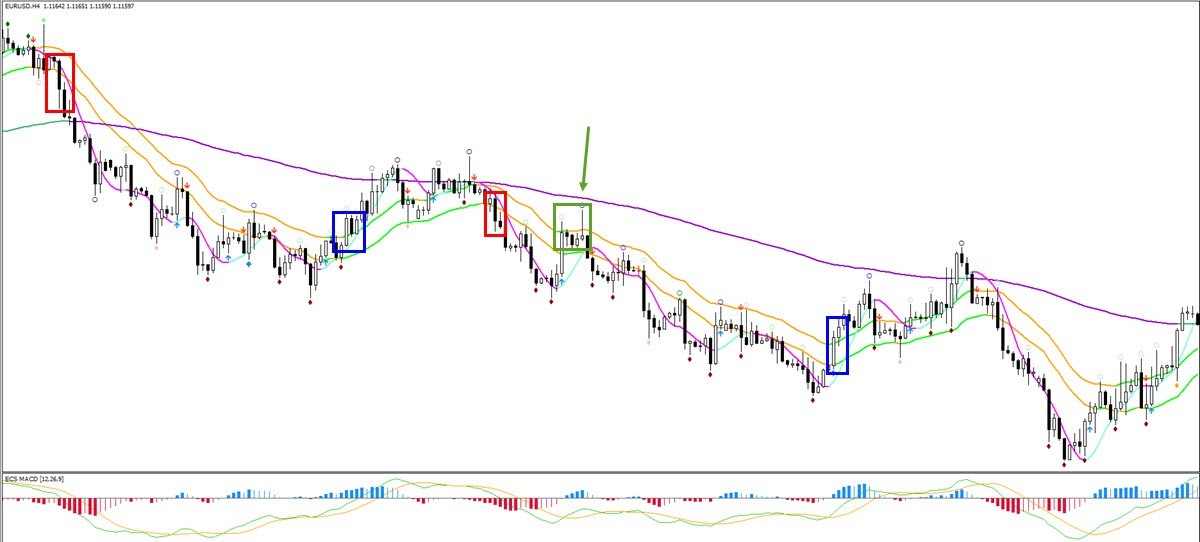Are you curious how price patterns, support & resistance (S&R), and trend & momentum can be used to analyse the charts in a coherent and strategic way?
This article will explain how traders can use the charts as a road map to figure out the most likely price path. Because price chooses the path of least resistance and traders can use the chart to figure out the likely path.
Traders will learn how to estimate the path of least resistance and how to treat price movements and trade setups as a probability. They will also learn cool new chart concepts such energy, gravity, and resistance. Let’s start with understanding the price trail.
Use Past Price for Estimating the Next Step
Supply and demand leaves a trail on the chart (past price). Traders can analyse that trail (price movement) and use it as a road map to understand what the next price movement could be. Analysing past price (past path of least resistance) helps traders estimate and forecast what the next step or two could be. Based on that, traders can then assess whether there are any interesting potential trade setups within that expected path.
The financial markets in general and the Forex market in specific are in a continuous tug of war between sellers and buyers (supply and demand). This creates price waves that are visible on almost all charts.
Image: swings (impulse folder)
Character of Waves
The waves are either impulsive or corrective in their character, which is in many ways like the heartbeat of the market. The charts beat with a regular movement of impulse and correction although the exact sequence and length of each impulse and correction will vary per chart and time period.
-
By analysing candlesticks, we understand the current price action and whether buyers, sellers or neither is in control.
-
By analysing groups of candles, we are actually analysing price swings, which helps us understand whether price is bullish or bearish and whether its corrective or impulsive.
-
By analysing multiple price swings, we can understand whether price is trending or ranging and also can comprehend wave patterns and price patterns, which helps us understand both the market structure and the balance between buyers and sellers.
-
By analysing supply and demand via wave patterns, price patterns, and trend versus range, the future path of least resistance can be determined.
The chart is a road map and analysing price swings is a critical piece of understanding the market structure properly and fluently. It is like learning a language. Of course, using a dictionary might help you overcome immediate hurdles, but the more fluent you speak, the easier it is to communicate with the environment around you. Charting, analysing technical analysis and trading itself also become easier (in the long-term) when you understand how to listen to the markets.
Remember the saying: the markets speak and traders listen. Traders should always follow the rhythm of the market rather than trying to outsmart or outguess the market, or look for any invisible short cuts. You can compare trading to dancing where the market leads and traders should follow the market’s lead. As a dancer, we are looking for clues about the market’s next step and analysing charts as a road map will help determine the expected price path of least resistance.
Analysing price swings and understanding whether price is impulsive or corrective helps traders understand the road map, path of least resistance, and overall market structure. Eventually impulsive price action will run out of steam, simply because nothing can move in one direction forever. The impulsive price action can however last for longer than you expect but the energy will eventually die down and candles will either become corrective and slow down in their movement or reverse into the opposite direction.
Image: price impulse 5 (impulse folder)
At first momentum is stronger than gravity but eventually momentum weakness and gravity becomes stronger, thereby pulling price into a correction, which is either in the opposite direction (reversal) or sideways direction (consolidation).
Determining the Price Swing
At every point on the chart, price has a choice to continue with the current price swing or complete the old one and start a new price swing. Traders are looking to understand these 4 aspects:
-
What is the direction and character of the current price swing?
-
Where and when will the current swing end?
-
What will be the direction and character of the next price swing?
-
What will be the direction and character of the price swing after the next?
The questions 1 to 4 can be reviewed on multiple time frames, although eventually this might become confusing. The best is to start low and gradually add more time frames when you have gained sufficient experience.
There are three factors that play a key role in determining whether a price swing will continue or end: it’s all about the speed of price in relation to the force of gravity and encountered resistance. In a way, it’s like a formula:
Energy versus Gravity plus Resistance.
Energy = presence of impulse and the pace of price. Impulsive price is quick whereas corrective price is slow moving.
Gravity = the chance of price being pulled back to its average.
Resistance = the ability of a strong support or resistance level to stop price.
It’s like a tug of war between gravity and energy (speed) with support or resistance which helps determine the limits. Imagine a scenario where you throw a tennis ball in the air. At the start, the tennis ball is moving fast and pulling away from earth and floor. Eventually the speed of the tennis ball decreases and eventually the gravity of the earth will pull it back down to earth. The presence of resistance could alter the path even sooner. Once the tennis ball hits the ceiling, it will bounce off of it and fall down earlier. But if a tennis ball would hit a soft structure like paper, then its speed will probably be sufficient to break through the paper ‘resistance’.
Now imagine that price is in the same role as the tennis ball. Let’s walk through that:
-
The tennis ball is thrown in the air: price is moving impulsively.
-
The tennis ball is pulling away from earth and floor: price is moving away from the moving averages.
-
Eventually the speed of the tennis ball decreases and eventually the gravity of the earth will pull it back down to earth: price is moving back towards short-term and long-term moving averages.
-
The tennis ball hits a hard(er) ceiling: price hits the support or resistance level and bounces or reverses from this zone.
-
The tennis ball hits a soft(er) ceiling: price hits the support or resistance level and breaks through this zone.
Traders must analyse energy, gravity, and resistance to understand in what stage (see points 1 to 5 above) price is currently in. This art takes practice and experience.
Understanding Price as Energy
Traders must compare energy with gravity and resistance and judge the expected road map based on that. Here are the key aspects to keep in mind.
Energy is determined and can be analysed by these factors:
-
The character of the candlesticks in the swing:
-
Is price moving impulsively?
-
Is price moving correctively?
-
Was the previous price swing an impulse or correction?
-
-
Chart patterns:
-
Presence of continuation chart patterns on lower time frames.
-
Presence of continuation chart patterns on the same time frame, which indicates that the previous impulsive swing is still a dominant factor.
-
-
Time patterns:
-
Impulsive price action is usually quick.
-
Corrective price action is often slow and lengthy.
-
Failure to confirm the trend with a higher high (during uptrend) or lower low (during downtrend) within 5-6 candles indicates a higher chance that a corrective zone will start.
-
- The relationship of price versus moving averages:
-
Price versus 21 ema versus 144 ema indicates trend.
-
Price above 21 ema above 144 ema = uptrend.
-
Price below 21 ema below 144 ema = downtrend.
-
-
Price action that is moving away from the 21 ema zone is impulsive. When price is not hitting the space between the 21 ema high or low (zone), then the price is moving quickly.
-
If there are multiple candles (+/- 5 or more) not hitting the 21 ema zone, then the swing is considered to be an impulse.
-
If there are 20+ candles not hitting the 21 ema zone, then the swing is considered to be an impulsive wave 3.
-
-
The angle of the HMA indicates the direction whereas the presence of the HMA outside of the 21 ema zone indicates impulse.
-
The ecs Fractal indicator versus the 21 ema zone:
-
Uptrend:
-
Support fractals around the 21 ema zone.
-
Resistance fractals above the 21 ema high.
-
-
Downtrend:
-
Resistance fractals around the 21 ema zone.
-
Support fractals below the 21 ema low.
-
-
-
Understanding Price as Gravity and Resistance
Gravity is determined and can be analysed by these factors:
-
Price is unable to pull away from the 21 ema zone. This indicates corrective price action, which often indicates that energy is weak and gravity could be stronger.
-
Divergence pattern. Price is able to make a higher higher or lower low but the oscillator, like the Awesome Oscillator, fails to confirm the new high or low. The oscillator shows a lower high (not higher high) or a higher low (not a lower low).
-
Chart patterns. Reversal chart patterns such as rising wedge, falling wedge, head and shoulders, double top or bottom and triple top or bottom indicate that price is likely to move back to the long-term moving averages.
Resistance is determined and can be analysed by these factors:
-
Attempts to break a support or resistance (S&R) zone:
-
The first attempt that price makes to break a S&R zone is always the most difficult and least likely to succeed.
-
The second attempt is 50-50% on average whether price breaks or bounces at S&R.
-
The third attempt or more usually favours the breakout rather then a bounce or reversal because price has already tested the S&R zone twice before and price has now made a significant reversal because price is again testing the S&R zone. Eventually price tends to make a break.
-
- Strength of a support or resistance zone:
-
Confluence of support and resistance makes a price level or zone stronger and hence makes it more difficult to break and more likely for price to bounce.
-
Less confluence makes it weaker and easier to break and less likely to bounce.
-
How Price Moves within Path of Least Resistance
Price movement is showing the path of least resistance. The path is decided by 2 main factors: energy and resistance. Or in other words, there is a continuous battle between momentum (energy) and support and resistance (S&R). Sometimes momentum is stronger than S&R. In other cases momentum is weaker than S&R.
-
If momentum wins, then the price will either continue its path with perhaps only a small interruption. The faster price is moving without showing divergence, the stronger the momentum will act.
-
If S&R wins, then the price will stop at S&R and revert into the other direction or go sideways. Generally speaking, the more confluence a support or resistance level has, the stronger the zone will behave.
It is, however, important to realise that the “formula” (S&R vs momentum) is an estimate based on your own analysis, experience and interpretation. Just keep in mind that it is not an actual formula - although it could be an interesting idea to pursue (if you are a programmer and want to build something like that with us, feel free to reach out to us).
So now you know how we can benefit from looking at a chart:
-
We analyse support and resistance.
-
We analyse momentum.
-
We estimate the expected path of least resistance.
-
We monitor our estimate and learn how to improve future estimates.
The estimated path of least resistance is always a probability. The path of least resistance is not fixed in stone but rather something more flexible”. Our wave and Fibonacci guide helps traders assess that path of least resistance.
Understanding Why Probability is Key
What we mean is that there is never a guarantee that the price will follow the path of least resistance as traders expect. The ability to understand the charts in a deeper way via the concepts of flow versus resistance does not mean that traders can forecast the future with 100% accuracy. Analysing and trading will always remain a question of probability.
Simply said, the path of least resistance, price movements and trade setups are always a probability, which varies from case to case and depends on the structure of the chart. Some price movements are very probable while others are indecisive. What we mean is that in some situations the chart is clearly bearish or bullish whereas in other situations the direction remains unclear.
The path of least resistance is not fixed. The probability of price moving up or down can also change when more information becomes available. Each new candle provides new information that could improve or reduce the probability that price will follow your expected path of least resistance.
Generally speaking, humans tend to be weak when assessing probabilities. Rare occurrences tend to be overestimated whereas a small probability edge tends to be underestimated.
For instance, it is not rare that people that are scared of being hit by lightning, even though the number of hits and fatalities by lightning has been dropping strongly in past centuries (Enlightenment Now The Case for Reason, Science, Humanism and Progress by Steven Pinker 2018 Allen Lane / Penguin Books). In fact, lightning could create more fear than for instance smoking cigarettes, which in fact has a much higher probability of causing problems for the health but in a more hidden and subtle way.
Another example is the underestimation of a rainy day. If the weather forecast service predicts a 30% chance of rain today, then that that actually means that 3 out of 10 days will see some level of precipitation. Many people interpret the 30% chance as a low probability. They think that the event is unlikely to occur just because the forecast is less than 50%. Humans tend to underestimate the usual rainy day and to overestimate how often lightning strikes.
The traits of a super forecaster can help traders become more realistic in their assessment of probabilities. Here are the key criteria:
-
Research a fair “base rate”: how often is something likely to occur?
-
Monitor changes: should the probability be adjusted or not?
-
Reaction: don’t underestimate potential changes but also try to avoid under reacting.
For more information about forecasting, I recommend reading the book “Superforecasting The Art and Science of Prediction” by Philip E. Tetlock and Dan Gardner by Crown Publishers 2015.
New information eventually changes the probability of your initial analysis and your expected path of least resistance and/or trade setups could become:
-
More probable (confirmation).
-
Less or zero probable (invalidation).
-
Remain the same.
Let’s provide an example. The EUR/USD was showing potential for a bearish reversal (left red box) as price broke below the 21 ema. The break below the 144 ema confirmed the reversal rather than just a retracement. Eventually price however managed to break above the 21 ema (left blue box) which makes a bullish retracement more likely. That is a moment where performing some trade management could make sense as the odds have changed.
The next red box indicates a bearish continuation after retracement to and bounce at the 144 ema. Traders who stayed in the trade are seeing the odds again in their favour. Those that exited can enter again. The green box indicates a decision zone but price fails to break above the 21 ema and shows a wick instead. The next blue box however indicates again a break above the 21 ema and a potential retracement. Once again the odds have changed and the trend is running out of steam.
Image trend 16 (trend)
New information is not only useful prior to the entry but also for trade management decisions if your trade management allows it. This is why active trade management (changing your exit point) has more potential than a passive trade management style (not allowed to change your planned exit) because it allows us to change the parameters of our trade after the entry. Active management allows us to use new information on the chart to make a more informed decision about exiting at the right price and timing.
The analysis has been done with the ecs.SWAT method and ebook.
Related read: Four chart patterns every trader should know
Chart patterns are effective tools for traders to find profitable opportunities in the market. Although several patterns exist, some patterns are more popular and tend to carry a higher probability of success than other patterns. The following four patterns fall into this category as they are widely known among experienced traders. Keep reading
Elite CurrenSea Training Program(s) should not be treated as a recommendation or a suggestion to buy or sell any security or the suitability of any investment strategy for Student. The purchase, sale, or advice regarding any security, other financial instrument or system can only be performed by a licensed Industry representative; such as, but not limited to a Broker/Dealer, Introducing Broker, FCM and/or Registered Investment Advisor. Neither Elite CurrenSea nor its representatives are licensed to make such advisements. Electronic active trading (trading) may put your capital at risk, hence all trading decisions are made at your own risk. Furthermore, trading may also involve a high volume & frequency of trading activity. Each trade generates a commission and the total daily commission on such a high volume of trading can be considerable. Trading accounts should be considered speculative in nature with the objective being to generate short-term profits. This activity may result in the loss of more than 100% of an investment, which is the sole responsibility of the client. Any trader should realise the operation of a margin account under various market conditions and review his or her investment objectives, financial resources and risk tolerances to determine whether margin trading is appropriate for them. The increased leverage which margin provides may heighten risk substantially, including the risk of loss in excess of 100% of an investment.
Editors’ Picks

GBP/USD slides toward 1.3300 after softer-than-expected UK inflation data
GBP/USD has come under intense selling pressure, eyeing 1.3300 in the European session on Wednesday. The UK annual headline and core CPI rose by 3.2% each, missing estimates of 3.5% and 3.4%, respectively, reaffirming dovish BoE expectations and smashing the Pound Sterling across the board.

EUR/USD declines toward 1.1700 on solid USD recovery
EUR/USD turns south and declines toward 1.1700 on Wednesday. A solid comeback staged by the US Dollar weighs heavily on the pair, as traders look to USD short covering ahead of US CPI on Thursday. However, the downside could be capped by hawkish ECB expectations.

Gold clings to modest gains above $4,300
Following Tuesday's volatile action, Gold regains its traction on Wednesday and trades in positive territory above $4,300. While the buildup in the USD recovery momentum caps XAU/USD's upside, the cautious market stance helps ithe pair hold its ground.

Bitcoin, Ethereum and Ripple extend correction as bearish momentum builds
Bitcoin, Ethereum, and Ripple remain under pressure as the broader market continues its corrective phase into midweek. The weak price action of these top three cryptocurrencies by market capitalization suggests a deeper correction, as momentum indicators are beginning to tilt bearish.

Ukraine-Russia in the spotlight once again
Since the start of the week, gold’s price has moved lower, but has yet to erase the gains made last week. In today’s report we intend to focus on the newest round of peace talks between Russia and Ukraine, whilst noting the release of the US Employment data later on day and end our report with an update in regards to the tensions brewing in Venezuela.
RECOMMENDED LESSONS
Making money in forex is easy if you know how the bankers trade!
I’m often mystified in my educational forex articles why so many traders struggle to make consistent money out of forex trading. The answer has more to do with what they don’t know than what they do know. After working in investment banks for 20 years many of which were as a Chief trader its second knowledge how to extract cash out of the market.
5 Forex News Events You Need To Know
In the fast moving world of currency markets where huge moves can seemingly come from nowhere, it is extremely important for new traders to learn about the various economic indicators and forex news events and releases that shape the markets. Indeed, quickly getting a handle on which data to look out for, what it means, and how to trade it can see new traders quickly become far more profitable and sets up the road to long term success.
Top 10 Chart Patterns Every Trader Should Know
Chart patterns are one of the most effective trading tools for a trader. They are pure price-action, and form on the basis of underlying buying and selling pressure. Chart patterns have a proven track-record, and traders use them to identify continuation or reversal signals, to open positions and identify price targets.
7 Ways to Avoid Forex Scams
The forex industry is recently seeing more and more scams. Here are 7 ways to avoid losing your money in such scams: Forex scams are becoming frequent. Michael Greenberg reports on luxurious expenses, including a submarine bought from the money taken from forex traders. Here’s another report of a forex fraud. So, how can we avoid falling in such forex scams?
What Are the 10 Fatal Mistakes Traders Make
Trading is exciting. Trading is hard. Trading is extremely hard. Some say that it takes more than 10,000 hours to master. Others believe that trading is the way to quick riches. They might be both wrong. What is important to know that no matter how experienced you are, mistakes will be part of the trading process.
The challenge: Timing the market and trader psychology
Successful trading often comes down to timing – entering and exiting trades at the right moments. Yet timing the market is notoriously difficult, largely because human psychology can derail even the best plans. Two powerful emotions in particular – fear and greed – tend to drive trading decisions off course.



